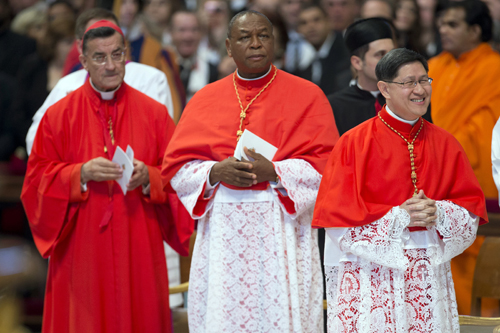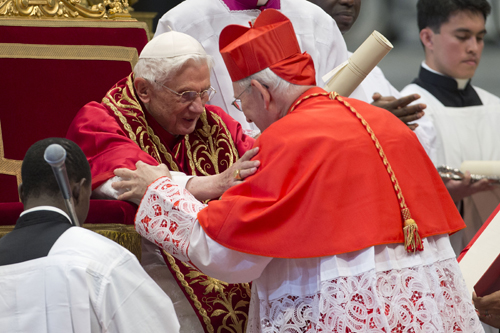Pope elevates 6 cardinals to choose successor

From left, Newly-elected Cardinals His Beatitude Bechara Boutros Rai, Patriarch of Antioch of the Maronites in Lebanon, Nigeria's Archbishop John Olorunfemi Onaiyekan, and Philippines Archbishop Luis Antonio Tagle, attend a consistory presided by Pope Benedict XVI inside St. Peter's Basilica at the Vatican, Saturday, Nov. 24, 2012. Six new cardinals are joining the elite club of churchmen who will elect the next pope, bringing a more geographically diverse mix into the European-dominated College of Cardinals. (AP Photo/Andrew Medichini)

Newly elected Cardinal James Harvey, right, of the US is greeted by Pope Benedict XVI after he received the red three-cornered biretta hat during a consistory in St. Peter's Basilica at the Vatican, Saturday, Nov. 24, 2012. Six new cardinals are joining the elite club of churchmen who will elect the next pope, bringing a more geographically diverse mix into the European-dominated College of Cardinals. (AP Photo/Andrew Medichini)


VATICAN CITY >> Six new cardinals on Saturday joined the elite club of red-robed churchmen who will elect the next pope, bringing a more geographically diverse mix into the European-dominated College of Cardinals.
Pope Benedict XVI presided over the ceremony in St. Peter’s Basilica to formally elevate the six men, who hail from Colombia, India, Lebanon, Nigeria, the Philippines and the United States. As Benedict read each name aloud in Latin, cheers and applause erupted from their friends and family members in the pews.
The ceremony was both joyful and emotional: Manila Archbishop Luis Antonio Tagle, seen by many to be a rising star in the church, visibly choked up as he knelt before Benedict to receive his three-pointed red hat, or biretta, and gold ring, and wiped tears from his eyes as he returned to his place.
Abuja, Nigeria Archbishop John Olorunfemi Onaiyekan, meanwhile, seemed to want to sit down and chat with each one of the dozens of cardinals that he greeted in the traditional exchange of peace that follows the formal elevation rite.
Benedict has said that with this “little consistory,” he was essentially completing his last cardinal-making ceremony held in February, when he elevated 22 cardinals, the vast majority of them European archbishops and Vatican bureaucrats.
Benedict said Saturday that the new cardinals represent the “unique, universal and all-inclusive identity” of the Catholic Church.
Don't miss out on what's happening!
Stay in touch with breaking news, as it happens, conveniently in your email inbox. It's FREE!
“In this consistory, I want to highlight in particular the fact that the church is the church of all peoples, and so she speaks in the various cultures of the different continents,” he told the crowd, which included Lebanese President Michel Suleiman, the vice president of the Philippines Jejomar Binay and lawmakers from India and Nigeria.
The College of Cardinals remains heavily European even with the new additions: Of the 120 cardinals under age 80 and thus eligible to vote in a conclave to elect a new pope, more than half — 62 — are European. Critics have complained that the “princes of the church” no longer represents the Catholic Church today, since Catholicism is growing in Asia and Africa but is in crisis in much of Europe.
The issue of numbers is significant since these are the men who will elect the next pope from among their ranks: Will the next pontiff come from the southern hemisphere, where two-thirds of the world’s Catholics live? Or will the papacy return to Italy, which has 28 voting-age cardinals, after a Polish and German pope?
The new cardinals do make the papal voting bloc a bit more multinational: Latin America, which boasts half of the world’s Catholics, now has 21 voting-age cardinals; North America, 14; Africa, 11; Asia, 11; and Oceana, one.
Among the six new cardinals is Archbishop James Harvey, the American prefect of the papal household. As prefect, Harvey was the direct superior of the pope’s former butler, Paolo Gabriele, who is serving an 18 month prison sentence in a Vatican jail for stealing the pope’s private papers and leaking them to a reporter in the greatest Vatican security breach in modern times.
The Vatican spokesman has denied Harvey, 63 from Milwaukee, is leaving because of the scandal. But on the day the pope announced Harvey would be made cardinal, he also said he would leave the Vatican to take up duties as the archpriest of one of the Vatican’s four Roman basilicas. Such a face-saving promotion-removal is not an uncommon Vatican personnel move.
Harvey’s departure has led to much speculation about who would replace him in the delicate job of organizing the pope’s daily schedule and arranging audiences.
Aside from Harvey, Tagle, and Onaiyekan, the new cardinals are: Bogota, Colombia Archbishop Ruben Salazar Gomez; the Patriarch of Antioch of the Maronites in Lebanon, His Beatitude Bechara Boutros Rai; and the major Archbishop of the Trivandrum of the Siro-Malankaresi in India, His Beatitude Baselios Cleemis Thottunkal.
Cardinals serve as the pope’s closest advisers, but their main task is to elect a new pope. And with Benedict, 85, slowing down, that task is ever more present. For the second time, the consistory ceremony was greatly trimmed back, lasting just over an hour to spare the pope the fatigue of a lengthy ceremony.
He will, however, celebrate Mass on Sunday with them.
While Benedict didn’t mention the cardinals’ primary task in his remarks, he did remind them that the scarlet of their cassock and hat that they wear symbolizes the blood that cardinals must be willing to shed to remain faithful to the church.
“From now on you will be even more closely and intimately linked to the See of Peter,” he said.
The six new cardinals are all under age 80. Their nominations bring the number of voting-age cardinals to 120, 67 of whom were named by Benedict, all but ensuring that his successor will be chosen from a group of like-minded prelates.
Saturday’s consistory marks the first time in decades that not a single European or Italian has been made a cardinal — a statistic that has not gone unnoticed in Italy. Italy still has the lions’ share of cardinals, though, with 28 voting-age “princes” of the church.





